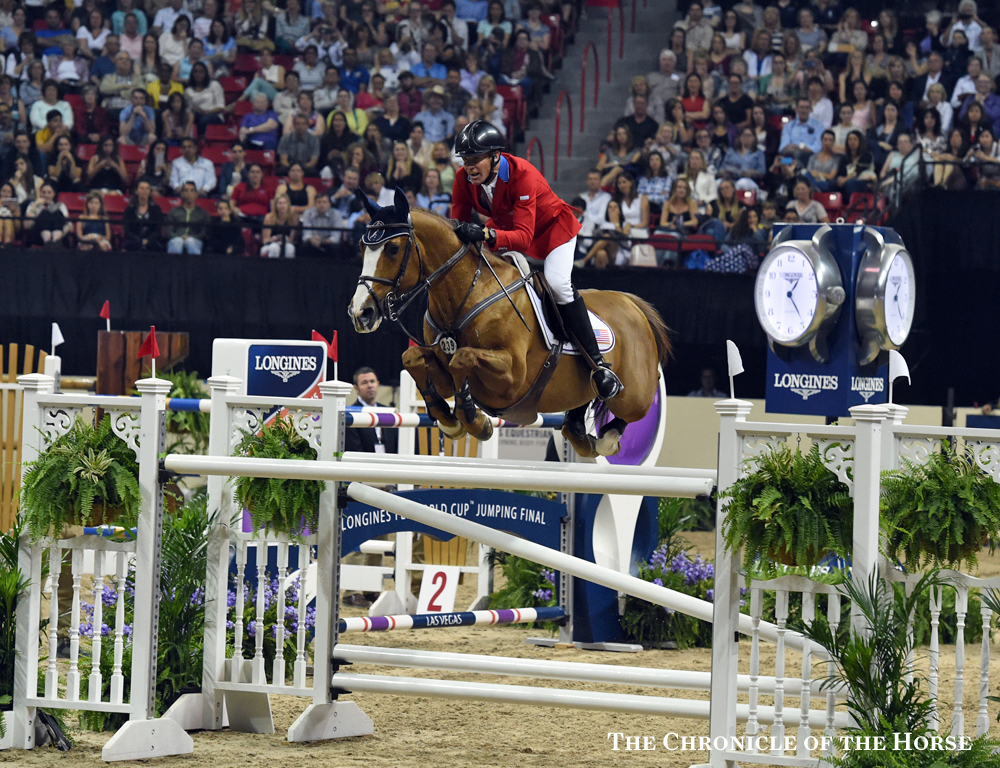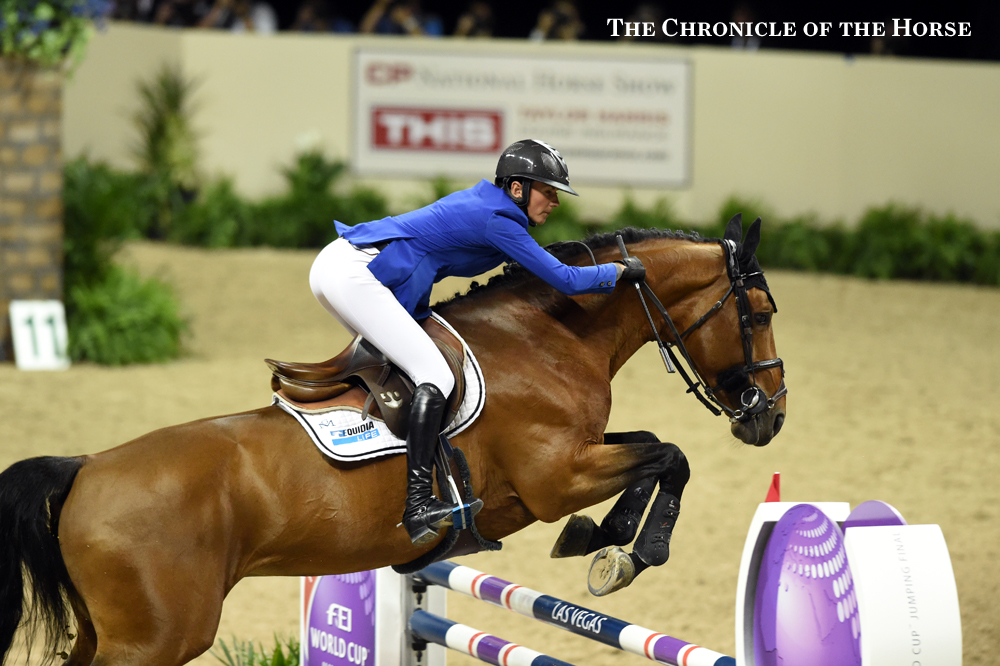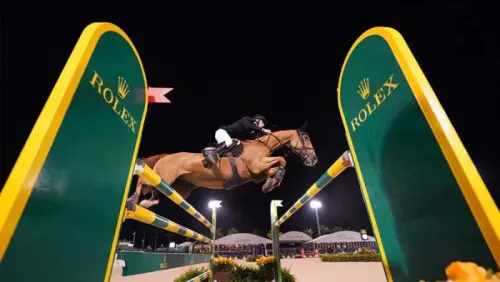Gothenburg, Sweden—March 25
Today the Longines FEI World Cup Show Jumping Final kicks off in Sweden, and we’ve compiled all that you could need to know before the first horse jumps.
Who’s here? And who’s not?
Just as in the dressage side of the competition, there are some headliner riders who qualified for the Final but declined to compete. It’s an Olympic year, and some riders are choosing to focus on their preparation for the Rio Olympic Games.
Some of the top U.S. riders who RSVPed “no” to the World Cup Final include 2013 Final winner Beezie Madden, McLain Ward, Kent Farrington, and Laura Kraut. So, some younger riders are stepping up to the bat, with Callan Solem, Peter Lutz, Audrey Coulter and Quentin Judge all jumping in their first FEI World Cup Final. Hardin Towell and Charlie Jacobs are both in Sweden for their second Final experience.
Katie Dinan, 22, is the youngest of the U.S. rider contingent, though she’s jumped in three World Cup Finals before.
Audrey Coulter is also representing the U.S. contingent, though she chose to qualify in the highly competitive Western European League. She finished seventh in that league to book a ticket to Gothenburg.
See more about the U.S. riders jumping in Sweden.

Flexible and Rich Fellers. Photo by Molly Sorge
Winner of the 2012 Final, Flexible is the oldest horse in the field, stepping up for his seventh World Cup Final at the age of 20. Rider Rich Fellers claims he feels younger than ever. Interestingly, “Flexi” is the same age as the youngest rider set to compete—Belgian rider Jos Verlooy.
Want to get to know Flexi better? Go Behind The Stall Door with him!
You can find a complete list of the entries here.
What’s Up When?
ADVERTISEMENT
The first leg of the Final is a speed leg, which kicks off at 6:15 p.m. in Sweden (1:15 p.m. Eastern Daylight Time). There are 62 horses on the start order.
The U.S. riders go: 5th-Charlie Jacobs; 8th-PeterLutz; 14th-Audrey Coulter; 15th-Katie Dinan; 16th-Callan Solem; 24th-Rich Fellers; 31st-Quentin Judge; 33rd-Hardin Towell.
Want to know more about the Reem Acra FEI Dressage World Cup Final? Check out our look at that side of the competition.
How to watch?
You can watch the tests on FEI TV. (You do need a subscription for the service.)
Follow along with our coverage at COTH.com, and our Instagram, Twitter and Facebook pages.
Who might win?
Of course, any U.S. fan’s sentimental favorite is Flexible—if he were to reprise his Final victory of three years ago at the age of 20, it would be an amazing story. Remember, last year in Las Vegas, Flexible was in the lead going into the last day and was seventh in the end. And the world has learned to never count Flexi out!
Riders from the Western European League include a bevy of former World Cup Final winners. The reigning World Cup winner, Steve Guerdat, is ready to defend his title, though he brought two younger horses, Concetto Son and Corbinian, instead of 2015 Final winner Albfuehren’s Paille or Olympic individual gold medal mount Nino des Buissonnets.
Other formers winners in the field include: Christian Ahlmann, Marcus Ehning, Daniel Deusser.
French stars Penelope Leprevost and Kevin Staut are ready to jump, as well as the young Belgian twin brothers Olivier and Nicola Philippaerts.

Penelope Leprevost on Vagabond de la Pomme in Las Vegas. She’s brought the same horse to Gothenburg this year. Photo by Molly Sorge
ADVERTISEMENT
The World Cup Final is famous for dramatic finishes, so it’ll be an interesting battle all weekend. In all, there are 38 riders from 18 nations jumping in the Final.
Where?
In Sweden! More specifically, at the Scandinavium arena in Gothenburg. This arena was the site of the first FEI World Cup Show Jumping Final in 1978, where Hugo Simon won on E.T. FRH, and has hosted 13 Finals before—most recently the joint finals in 2013.

The ring where it happens. Photo by Lisa Slade
How Does The World Cup Scoring Work?
The riders compete in the first leg on March 25, a speed class run over a 1.50-meter course. The World Cup Final rules read: “It is not intended that this course should have the character of a Table C “Speed and Handiness,” but rather a type Table A course with bigger fences. The sole purpose for using Table C scoring is to give a skillful athlete with an unlucky knockdown an opportunity to obtain a reasonable placing.”
Many riders have won the Final without winning the speed leg, but if they’re well down the rankings in the speed leg, it’s hard to battle back up to the top. Riders aim for a top-five placing in the first leg if they’re eager to win.
The second leg, which will be on March 26, is a Table A jump-off class set at 1.50 to 1.60 meters. It’s run like a typical grand prix class, with all the riders jumping clear over the first round returning for the jump-off.
After the first two legs of competition, the scoring gets interesting. The riders are assigned points depending on their placings in each class. For each leg, the winner gets 1 more point than the number of starters in that leg. Second place gets 2 points less than that, and each placing down the line gets 1 less.
The scoring system then gets creative, with the points being converted to faults. The scoring adds up the points for each rider from Rounds 1 and 2, and the rider with the highest points is assigned 0 faults. For all other riders the number of penalties will be assigned by giving them half the difference of their World Cup points and that of the leading rider. So, if the leading rider had 64 points and Beezie Madden has 42, the leading rider will have 0 faults going into the final day, while Madden would have 11 faults.
After a rest day on March 27, the riders and horses return for the final day on March 28, in which they jump two rounds. These rounds are over 1.50- to 1.60-meter courses, and “approximately equal in the number of obstacles and length of the course, with the second round having an increased level of difficulty,” according to the FEI rules.
Any faults in these two rounds are added to the rider’s total, and the rider with the least amount of faults at the end of the day wins! In rare instances, there have been ties for first place, which are broken with a jump-off. Rich Fellers’ historic 2012 Rolex FEI World Cup Final win with Flexible ended in a jump-off against Steve Guerdat and Nino des Buissonnets. Ties further down the placing remain as ties.














